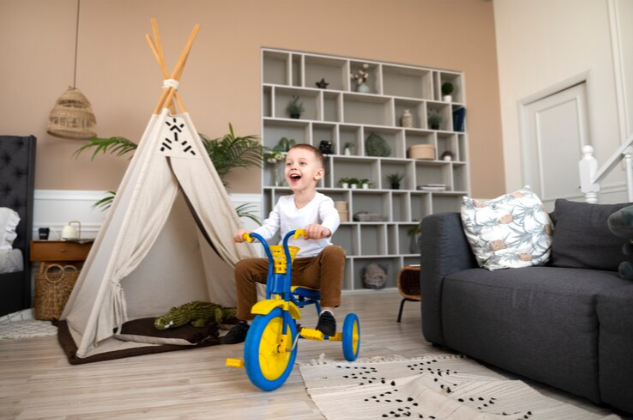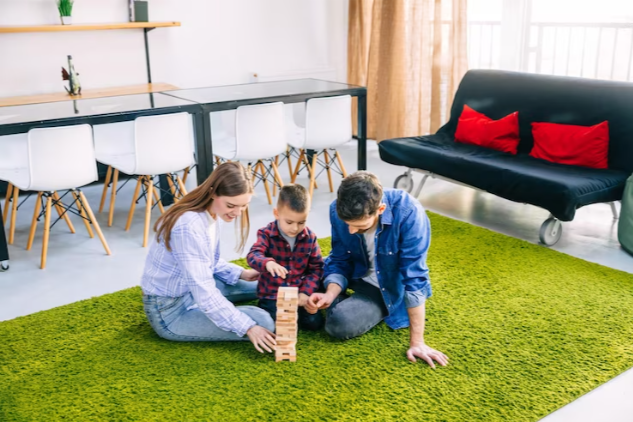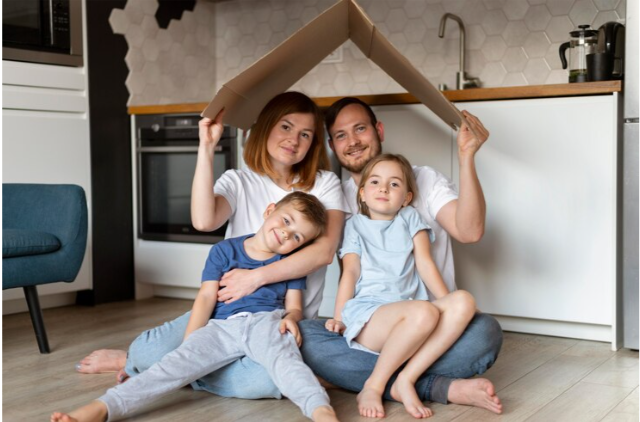Discover how to create a safe, nurturing, child-friendly home. Learn about childproofing, educational spaces, and balancing family needs.
Recognizing the Value of a Child-Friendly Environment
Beyond only ensuring a child’s safety, a child-friendly home should promote an atmosphere that enhances all aspects of the child’s growth. A supportive environment like this provides a basis for social, intellectual, emotional, and physical development. It promotes learning and exploration by offering a secure environment where kids can push boundaries, make errors, and find their passions. A home that is conducive to growing self-assured, self-reliant, and imaginative children is essential. It’s not enough to simply modify a room to suit a child; it should also change as they do to accommodate their ever-expanding demands.
First Safety First: Make Your Home Childproof
Safety is the top priority in every house that welcomes children. Childproofing is a continuous process that changes to accommodate your child’s developing skills and interests. The fundamentals include mounting safety gates at stairwells, fastening bulky furniture to the wall to prevent toppling, and making sure all potentially dangerous items are out of reach.
While non-slip mats and faucet covers can help avoid spills in the bathroom, stove knob covers and appliance locks become crucial in the kitchen. Important precautions include having a fully supplied first aid kit, locking windows and balconies, and doing routine checks for small things that could be a choking danger. The intention is to provide a space where parents can feel at ease and children can explore safely.
Establishing Learning Environments
Stimulation is just as important as safety in a kid-friendly household. Setting aside particular areas for learning can have a big impact on a child’s growth. A cozy reading area with easily available books that are suitable for young readers can foster a love of reading at a young age.
Puzzles, construction blocks, and art supplies on a tiny table or desk can promote creativity and problem-solving skills. Technology can be an effective teaching tool if it is used properly. Learning can be made more enjoyable and engaging by creating a specific area for screen time that has restrictions and guided access to educational applications and games.
Developing Creativity via Play
Play is childhood’s labor, and a child-friendly home serves as its workplace. Areas that promote creative play, such as a shelf containing a variety of musical instruments or a section filled with outfits for dressing up, are priceless. A creative space can be created with an art station that has supplies like paint, paper, crayons, and other art supplies. Toys and activities that rotate may keep the area interesting and new, encouraging curiosity and creativity all the time. To enable children to explore and create in ways that are entirely their own, it is important to provide them with resources and experiences that encourage open-ended play.

The Great Outdoors: Encouraging and Safe
Playing outside is vital for a child’s development, both emotionally and physically. An exciting, safe outdoor area can offer a wealth of chances for discovery and adventure. The first thing to do is to secure your yard’s perimeter. Next, think of play structures that are suitable for their age, such as sandboxes, swings, and slides. Children can learn a lot about responsibility and the natural world from a modest garden. Whether it’s a tiny balcony or an expansive backyard, the idea is to provide an area that encourages kids to run, jump, dig, plant, and dream.
Creating a Space That Is Both Adult- and Child-Friendly
Finding a balance is key to keeping a house that is both kid- and adult-friendly. It is possible to satisfy the aesthetic and functional needs of adults while still designing environments that are secure and engaging for kids. Choose toy storage options that are both conveniently tucked away and readily available. Select strong, hygienic materials that appear elegant while withstanding the rigors of child play. Make sure that the entire house doesn’t turn into one big playroom by designating areas for adults to unwind and enjoy. Making a house that suits and reflects the demands of the entire family is crucial.
Including Kids in Household Maintenance
Including kids in environmental care is not only sensible but also instructive. Little ones can assist with basic duties like feeding a pet or gathering up toys. As kids get older, duties might be expanded to include putting away laundry, arranging the table, or taking care of plants. Children learn self-reliance, responsibility, and the importance of supporting their families through these activities. They also teach kids that keeping a nice, functional environment requires teamwork and helps them feel more a part of their home.
Including Kid-Friendly Design Features
A child-friendly home must have both utilitarian and aesthetically pleasing features that appeal to both adults and children. Think about adding creative patterns, vivid colors, or imaginatively themed spaces as playful accents. Use blackboard paint or wall decals to make spaces where kids can freely express their imaginations. Playthings can be stored in built-in toy storage,, or child-sized furniture can be both entertaining and practical. Recall that a child-friendly design doesn’t have to sacrifice your home’s overall aesthetic—instead, it just requires ingenuity to combine the two harmoniously.
Choosing Sturdy and Secure Materials
In terms of materials, a child-friendly home must prioritize safety and longevity. Choose materials and upholstery that are stain- and spill-resistant and easy to clean. Low-pile carpets and rugs are easier to vacuum and should not cause trips. Soft edges and rounded corners on furniture can help shield users from falls and impacts. Think of resilient, easily cleaned microfiber for upholstery or hardwood floors with a strong finish that can handle a lot of foot activity and play.
Creating a Schedule and Structure
The turmoil and worry that might occasionally accompany parenting children can be greatly diminished by keeping your child-friendly home well organized. Designating designated areas for toys, clothing, and other possessions motivates kids to help maintain a clean and organized home. Give them a visual and simple way to organize things by using labels, boxes, and shelves. Creating a schedule for everyday tasks and cleanup periods can aid in keeping the house organized and instill in kids the value of making contributions to the family.
Establishing a Multisensory Ambience
All the senses should be satisfied in a child-friendly home. Think about combining different hues, patterns, and textures that arouse the senses of touch, sight, and even smell. An area can be made cozier with cozy draperies, plush pillows, and tactile carpets. A child’s eye level is ideal for artwork and décor since it stimulates their sense of sight and encourages curiosity. You may also add natural scents and textures indoors by starting a small herb garden or using non-toxic plants.
Encouragement of Exercise
Promoting physical exercise is essential for a child’s growth and wellbeing. Set aside a space, if possible, for energetic play in a child-friendly home. A small indoor trampoline or a playroom with tumbling mats would be good examples. Think about putting things like yoga mats or jump ropes that are simple to store away in smaller areas. A basic ball, swings, or climbing frames can be installed in outdoor areas to facilitate different kinds of play. Recall that encouraging physical exercise involves more than simply providing equipment—it also entails fostering a culture where movement is appreciated and encouraged.
Using Technology Savvily
In the current digital era, most homes are fully integrated with technology. In a child-friendly home where kids are welcome, it’s critical to use technology responsibly. Establish a tech area where kids may use iPads, PCs, and gaming consoles while being watched over. Establish explicit guidelines and time restrictions for screen time, and promote age- and education-appropriate media. In order to make sure kids are secure and safe online, you should also think about putting up parental controls.

Developing an Appreciation of Nature
Encouraging children to engage with nature is crucial for their overall growth and welfare. Bring natural aspects into your house with natural materials like wood or stone, indoor plants, and nature-inspired décor. Make a little indoor garden so kids can learn how to take care of plants, or place a bird feeder near a window so they can see birds and other wildlife. If you have an outdoor area, think about creating a butterfly garden, a vegetable garden, or just a place where kids can play, dig, and plant.
In conclusion, a never-ending journey
Making and keeping your house kid-friendly is an ongoing process that changes as your family does. It all comes down to providing a warm, safe, and engaging environment where kids can develop, learn, and play. Recall that a caring atmosphere that satisfies the needs of both adults and children is the aim, not perfection. With careful planning and continuous improvement, your house can become a place where lifelong learning takes root and memories are created.
A dynamic, changing environment that adjusts to the developing needs of its youngest occupants is a house that is child-friendly. While learning, creativity, and discovery are all highly valued here, safety is the top priority. The benefits of creating such an environment are incalculable, but it takes careful planning, work, and constant adjustment. More than just a physical area, a child-friendly home serves as the setting for a contented childhood and the basis for an independent, well-rounded adult. Parents can create an environment that is truly nurturing for everyone by taking into account the requirements of both adults and children, including the entire family in its maintenance, and placing a high priority on safety and stimulation.
We hope you found this information helpful in your journey to create a safer environment for your family. At GuardWell Safety, we understand that every home is unique, and so are your child-proofing needs. That’s why we offer a Free Child-Proofing Consultation tailored to your specific requirements. Let our experts help you identify potential hazards and provide personalized solutions to make your home a secure haven for your little ones. Book your free consultation today and take the first step towards peace of mind.






